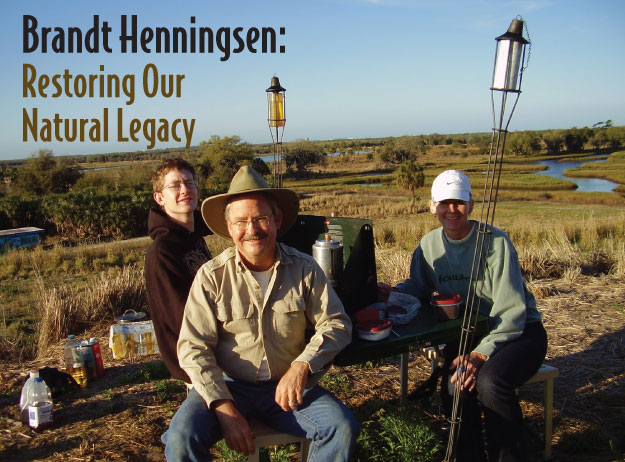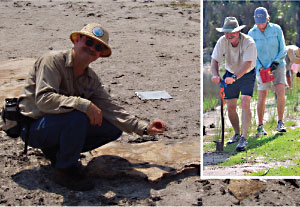[printfriendly]
Profile:
By Mary Kelley Hoppe

The quiet mangrove coves and lush marshes rimming Cockroach Bay Preserve near Ruskin in southern Hillsborough County give no hint of the decades-long transformation there. Lands once used for farming and mined for shell used as road base now harbor freshwater and tidal lagoons and uplands teeming with wildlife.
For Dr. Brandt Henningsen, chief environmental scientist with the Southwest Florida Water Management District, it’s been a labor of love and patience 20 years in the making.
Hillsborough County purchased the 651-acre tract in 1991, opening the way for one of the largest and most complex coastal ecosystem restoration projects ever conducted on Tampa Bay. Tasked with designing and overseeing construction of the project for the district’s Surface Water Improvement and Management (SWIM) program, Henningsen has been a driving force since day one. But he’s quick to credit the county and more than 20 collaborating partners for the success of the project, which was completed in phases as money and manpower became available.
“We couldn’t have done this alone,” says Henningsen. “The partnerships have been key in allowing this to move forward and be successful.”
One of the first to join the SWIM program in 1987, he’s helped design and plan over 40 habitat restoration projects, including nearly 2,500 acres of coastal habitat along Tampa Bay. He’s become a leading advocate for habitat conservation in Tampa Bay and an authority on coastal habitat restoration. The Tampa Bay Association of Environmental Professionals recently honored him with its 2012 Environmental Excellence Award.
“His day-to-day involvement in the field has made him the high-level designer he is,” says Tom Ries, vice president of Scheda Ecological Associates, who worked with Henningsen at SWIM for more than a decade. “By being hands-on, Brandt sees the nuances that make or break a project.”
That hands-on attention is critical when success or failure may be measured in inches, Ries said. For instance, some marsh grasses die if they are planted above or below the water line. “It can come down to a fraction of an inch and if you don’t get the grading and slope right, the plants won’t grow properly.”
“We try our best to put back the full suite of habitats that normally would be found in Tampa Bay,” Henningsen says. “It’s kind of like putting a puzzle together — you want to make sure each piece meshes seamlessly with the other components.” It’s infinitely more complex as projects are designed to be multi-functional, encompassing habitat restoration, treating stormwater runoff to improve water quality, and improving hydrology.
Happiest in the Field

Unlike many senior scientists and engineers, Henningsen is happiest in the field where his energy and passion are infectious. Over the years, he’s led countless tours and worked with thousands of volunteers — mostly on weekends — to rid sites of exotic plants, install marsh plants and clean up shorelines. “It changes their perspective and gives them an understanding of why this work is so important,” he says.
“Brandt really loves to share his passion for conservation and see people take up the torch and carry it forward,” says his wife, Lisa, who spent 22 years with the district as an environmental scientist. The two met at the University of South Florida in the early 1980s where she was an undergraduate biology student, while he was completing his PhD.
Romance blossomed two years later when Henningsen invited Lisa to join him for a 5K run. In 1984, a year before they were married, the couple ran the Boston Marathon as ‘bandits’ — unofficial runners. Since then the avid runners have logged thousands of miles together.
That drive and determination, along with a love for all things outdoors, traces back to his childhood in Stephensville, Texas. He was an Eagle Scout, camping and exploring the forests around his home with his two brothers, and fossil hunting with his father, a geologist and university professor.
But it was a dime-store snorkel and mask, a gift from his parents when he was 10, that forever changed him. “The first time I stuck my head underwater, it was like a light came on and I knew I wanted to be a marine biologist,” Henningsen recalls. He immersed himself in the popular TV series Sea Hunt and the adventures of ocean explorer and researcher Jacques Cousteau, who pioneered and inspired marine conservation. “Cousteau became my hero.”
Henningsen went on to study marine biology at Lamar University and earned a masters degree in biology from Texas A&M before moving to Tampa to attend USF. The restoration projects he has directed have earned national and international recognition for Tampa Bay.
“There’s real satisfaction seeing these natural communities evolve, mature and change over time,” Henningsen says. “People will look back and be thankful for these wild spaces.”
[su_divider]Originally published Spring 2012